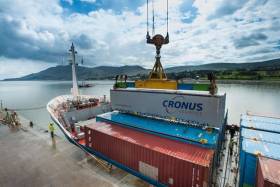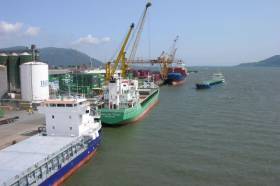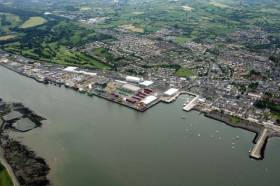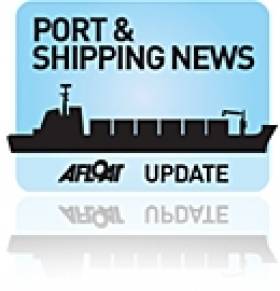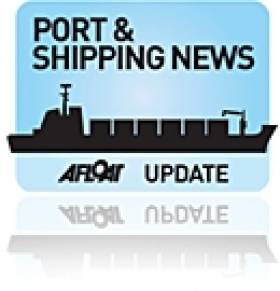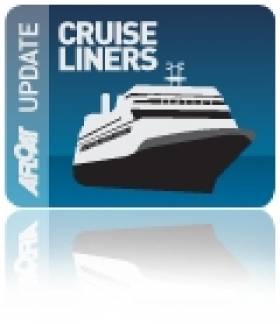Displaying items by tag: Warrenpoint Harbour Authority
New CEO Appointed by Warrenpoint Harbour Authority Marks Historic Milestone
#Ports&Shipping- Clare Guinness has been appointed as the new chief executive officer by the Warrenpoint Harbour Authority, the first female head of any port on the island of Ireland.
She joins from Fane Valley Group, where she held the position, Director of Corporate Services. During her time at Fane Valley, she played an instrumental role in the sale of the dairy to Lakeland and the joint ventures between Slaney, Linden Foods and ABP.
Clare Guinness also held senior roles during 17 years with the Bank of Ireland, working within the Real Estate and Business Banking divisions across Belfast, Dublin and London.
Stan McIlvenny, Chairman of the Warrenpoint Harbour Authority, said: “The Board is delighted to have secured the appointment of Clare Guinness, who has a wealth of corporate experience across multiple jurisdictions. We look forward to working with Clare as she leads the development of the Port’s strategy, and building on its growing contribution to the local economy".
Clare Guinness will take up her role in January.
Public Take 'Saga-Selfies' As Cruiseship Makes Return Call to Warrenpoint
#cruiseliners - Warrenpoint Harbour welcomed the return call of a cruiseship to the Co. Down port that first launched this trade in recent years, writes Jehan Ashmore.
Saga Pearl II had arrived into the scenic surroundings of Carlingford Lough last week having among its all-Ireland ports of call included Cobh, Cork Harbour.
The southern port this year had its first cruiseship, Saga Pearl II as Afloat previously reported.. The photo supplied for that coverage was actually that of her namesake predecessor, Saga Pearl which currently operates for other another company.
At just 18,000 gross tonnes, Saga Pearl II has the advantage of getting to visit smaller and lesser well known ports in Ireland and the UK as part of cruise itinerary also launched in recent years. This allows Saga cruisegoers to reach destinations that most giant cruiseships cannot.
On this rare occasion of a cruiseship call, Warrenpoint Harbour Authority organised a special public opening of the port through the Town Dock Office. This was to enable the public to gain access to view Saga Pearl II. Previously the cruiseship's historic first port visit in 2014 also drew in the crowds.
The public on this latest call were encouraged to get a 'Saga-Selfie' with the background of the cruiseship described by owners as a small yacht-like ship. With no more than 449 passengers on board and reserved exclusively as an adults-only ship.
There are seven passenger decks. Across these decks are facilities that include a small cinema, gymnasium, spa, hair and beauty salon, library, shop, card room and a
launderette.
#ContractExtended - Seatruck Ferries an Irish Sea freight-only operator have signed a 10 year extension to their agreement with Warrenpoint Harbour Authority.
The agreement underlines the operators commitment to the port at a time of growing volumes on the Warrenpoint-Heysham route.
A twice daily roll on roll off ferry service connects the Co Down and Lancashire ports that began running in April 1996. Since then the service has gone from strength to strength with a €70m investment in a pair of purpose built ferries introduced in 2007. At the same time Warrenpoint Harbour Authority also provided a new loading ramp and upgraded terminal facilities.
Seatruck are the largest tonnage operator in Warrenpoint and in 2016 the service had a record year with well over 100,000 shipments for the first time in its history. The Seatruck Warrenpoint service saw the fastest percentage freight growth of any Northern Irish ferry service in 2016.
As part of the new agreement Warrenpoint harbour have committed to provide additional terminal space in the port as is required to cope with future growth predictions.
Seatruck specialise in the shipment of unaccompanied trailers on routes which reduce road mileage for operators compared with the more traditional transit through Scotland or Wales. Continued HGV driver shortages, particularly in the UK, are contributing to an increasing market switch to the Seatruck model.
CEO of Seatruck Ferries Alistair Eagles commented; Warrenpoint is where the Seatruck story began and we are absolutely delighted to extend our agreement with the Port and in turn our commitment to the local area. The wider financial benefits of having a successful Port in this area should not be underestimated. Warrenpoint Harbour is the economic heartbeat of Newry and Mourne and more widely on both sides of the border. We now need to ensure that we have the arteries clear to ensure that the blood can flow freely and we welcome the progress being made on the Newry Southern Relief Road.
Chief Executive of Warrenpoint Harbour Authority Peter Conway also commented; “Warrenpoint Port is delighted to continue its long standing business relationship with Seatruck Ferries with the signing of the ten year extension to the contract. Seatruck is a fast growing innovative Ferry operator with a long and successful history at Warrenpoint. Together both companies hope to continue to grow the business and to provide and develop this modern cross channel Roll on Roll off service. Seatruck is the port’s largest customer and this new deal demonstrated its commitment to the port and the region for the long term".
He added "As Northern Ireland’s second general cargo port Warrenpoint Harbour is a major economic driver for its local region and its position half way between Dublin and Belfast on the island of Ireland is a major benefit in attracting business. The port continues to lobby for the construction of the Newry Southern Relief Road to further improve access to the major road network.”
Record Breaking Volumes for Warrenpoint Port
#Warrenpoint - Trade figures for Warrenpoint Harbour Authority released today reveal record volumes in tonnage of goods imported and exported through the Co. Down port for the year 2016.
The port recorded 3.48 million tonnes of cargo – a 7.4% growth on 2015 figures.
This reflects a record breaking achievement for the harbour authority whose new website highlights that a total of 969 vessels called to the port last year.
Volumes include significant increases in the roll-on/roll-off trade, containers, animal feed imports for the agri-food sector, timber and steel imports, export of cement and recyclables. In addition to various other general cargoes including coal and fertiliser.
New business included the development of the port as a cruiseship destination (Afloat adds the inaugural caller Saga Pearl II, firstly in 2014 and also last year). The port has also handed project cargoes including wind turbines.
Chief Executive, Mr Peter Conway, said “Another strong performance by the Port reflects the recent improvements in the economy both in Northern Ireland and the Republic of Ireland. The Port remains a major economic driver for its hinterland creating prosperity and securing additional employment”.
Cronus Welcomes UK Chancellor Osborne to Warrenpoint Port
#BREXITport? - The UK's Chancellor of the Exchequer George Osborne reports MultiModal, met senior executives from Warrenpoint Harbour Authority (WHA) and local MP's during a visit to the Co Down port yesterday.
The Chancellor met MP Margaret Ritchie, along with Nicola Walker and managing director of Cronus Logistics, as previously reported on Afloat.ie, new operator of Irish Sea container feeder services. This includes the only Ireland-Wales service connecting Dublin and Cardiff along with Belfast and Bristol.
The Chancellor was shown round the docks and observed ro/ro and containerised operations along with the discharge of bulk grain ships. He was also shown timber that is imported through Warrenpoint but ultimately is transported across the land frontiers into the south of Ireland.
“We are pleased that the Chancellor recognises the importance of Warrenpoint as a strategic port for imports and exports in Ireland,” says Nicola.
Speaking to the media during his tour he said, “I’m here at Warrenpoint and it’s a very practical demonstration of the fact that Northern Ireland has the only land border with an EU country… If we quit the EU, this is going to be the border with the EU.”
He later crossed the border on a lorry delivering timber into Dublin.
Overheating Ship's Cargo Hold and Oil Spill Incidents at Warrenpoint
#Vesselincidents - Within a fortnight two separate incidents involving a pair of vessels berthed in Warrenpoint, took place at the Co. Down port on the shore of Carlingford Lough.
Last week, overheating of cargo on board a hold of the M.V. Cimbris was detected by the vessel's captain who informed Warrenpoint Harbour Authority (WHA) which requested the fire brigade service.
The port authority implemented their emergency response plan and several units from the Northern Ireland Fire and Rescue Service were dispatched to the Cimbris which had arrived from Riga.
Peter Conway, CEO of the port authority confirmed that of the 3,000 tonnes of animal feed, 2000 tonnes had already been discharged prior to the incident on board the vessel whose berth was cordoned off for safety reasons.
Commenting on the incident, "I wish also to compliment the speed with which the emergency services responded to this incident".
The second incident as previously reported on Afloat.ie, had involved a small discharge of marine fuel from a vessel berthed at the port on 22 October.
The fuel was detected on the water's surface by the ship's captain who informed WHA which led to the port activating their oil contingency plan.
A team trained in oil spill recovery put in place around the vessel oil spill booms in addition to securing the affected area through the deployment of absorbent pads.
With a rising tide some oil had been detected along the shore adjacent to Narrow Water, the area was subsequently cleaned and oil residue removed as part of the port's contingency plan.
The Northern Ireland Environmental Agency, the Department of the Environment, Newry and Mourne District Council, the Loughs Agency and other agencies were informed. They assisted Warrenpoint Harbour in the remediation of the shore line at this location.
An investigation into the spill was instigated to determine the cause of the incident.
UK Ports Conference Heads for Warrenpoint Port
#UKportConference – Warrenpoint Port is to host the British Ports Association's 2014 conference on the 1 and 2 October.
This is only the second time in the 22 year history of the BPA that a venue has been held in Northern Ireland.
As reported yesterday on Afloat.ie, the Co. Down port is experiencing an upturn in trade in addition to welcoming the first cruiseship caller to the scenic setting of Carlingford Lough.
The flagship industry event is expected to attract approximately 200 delegates including BPA Members and Non Members, industry partners and key stakeholders.
It provides the main opportunity for the industry to discuss all the latest policy, practice, trends and technology developments in the ports and harbours sector from across the UK and Europe.
The event will be based in the nearby Hastings Slieve Donard Resort & Spa in Newcastle, and is also attract delegates from across the island of Ireland and further afield.
As in previous years the 2014 conference will offer a unique opportunity for BPA members and non members alike, to catch up with all the latest policy, practice, trends and technology in the ports and harbours sector from across the UK from a range of industry speakers.
For further details visit the BPA website here for registration, conference programme and contact details.
#CruiseCarlingford- Furthermore to our previous report on Warrenpoint Port, the harbour welcomed the first visit of a cruise ship, the Saga Pearl 2 last month to the harbour on the shores of Carlingford Lough.
According to the Belfast Telegraph, the (Saga Cruises) ship was making a Britain and Ireland Explorer cruise with 800 people on board, who disembarked in the local town and visited the region.
CEO of Warrenpoint Harbour Commissioners Peter Conway said, "We are hoping that this is the start of new business for us and that we can help welcome more tourists to this beautiful part of Co Down. There are also plans for a 200-berth yachting marina and we are trying to secure funding."
Mr Conway added: "We would be prepared to invest £2m in this £5m project; there is an inherent demand for leisure activity on Carlingford Lough."
It's understood the port has also been in negotiations with a view to a possible purchase of the port at Greenore in the Republic, the only privately-owned port in Ireland.
The port is most famous for being used to fit out the ships used for the pirate radio station Radio Caroline which Afloat.ie reported about the 50th anniversary since first broadcasting across the Irish Sea off Ramsey, Isle of Man in 1964.
Mr Conway said he had ambitions to broaden the port's appeal. "Warrenpoint is primarily a commercial port, but we have other stakeholders and we think that it is important that we put something back into the local community which is why we want to develop the cruise business and marina, and open up this part of Northern Ireland to a wider audience".
Warrenpoint also accommodates a small but successful mussel-dredging fleet, selling to customers in the Netherlands and Belgium. Local fishermen also sell scallop and crab to some of the top Northern Ireland restaurants.
The board in December 2013 also agreed to the construction of a new £3m grain storage facility and conveyor system.
In October this year the Warrenpoint Harbour Authority will host the 2014 British Ports Association (BPA) 2014 annual conference.
The event, to be based at the Slieve Donard Resort in Newcastle, is expected to attract around 200 delegates.
Warrenpoint Harbour Authority
Warrenpoint Harbour Authority
Warrenpoint Harbour Authority seeks to operate profitably within fair and competitive tariff arrangements so that the Port is economically sustainable. Its aim is to contribute as much as possible to the generation of economic wealth within the Port and its regional hinterland.

Consequently, profit optimisation, to achieve its primary mission rather than profit maximisation, will be pursued.
History
The original Port of Warrenpoint, consisting of a wet dock and piers, was constructed in the late 1770s by Roger Hall, Robert Ross and Isaac Corry with the assistance of £500 of public funds. In 1919 the heirs of Roger Hall sold the Port to John Kelly and Sons for the sum of £16,000. John Kelly continued to operate the Port until 1971 when it was sold to Warrenpoint Harbour Authority for £369,000.
The Port was substantially enlarged with an initial total investment of approximately £6.7million to create the modern Port of Warrenpoint. Until 1971 the Port of Warrenpoint acted as a lightering port for the Port of Newry and jointly these ports handled approximately half a million tonnes of cargo annually. Subsequently the modern Port of Warrenpoint has handled 5 times as much cargo on an annual basis.
Warrenpoint Harbour Authority, The Docks, Warrenpoint, Co. Down, N. Ireland BT34 3JR. Administration/General Enquiries – Tel: 028 417 73381 • Fax: 028 417 52875. Operations – Tel: 028 417 52878 • Fax: 028 417 73962• Email: [email protected]



























